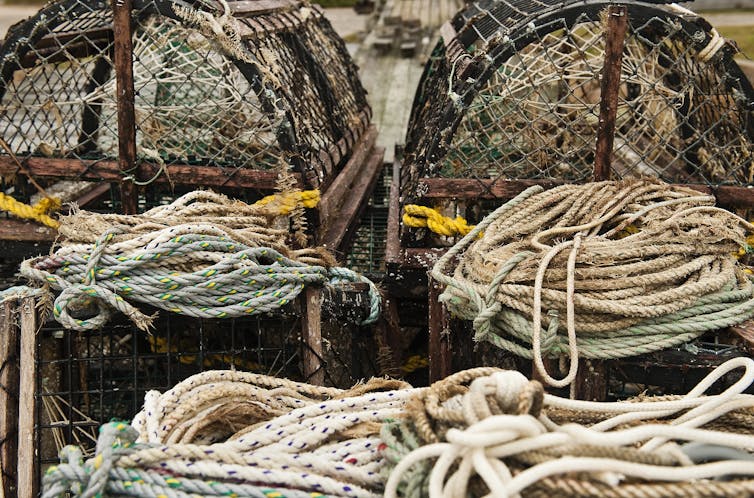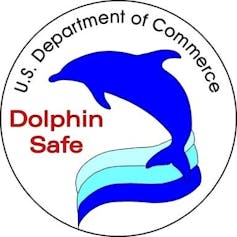The latest chapter in a long quest to make fishing more sustainable
Blake Earle, Texas A&M University
 |
| Lobster fishing uses a lot of rope, and whales can die after becoming entangled in it. MyLoupe/Universal Images Group via Getty Images |
The rules would have required lobstermen to create new seasonal nonfishing zones and further reduce their use of vertical ropes to retrieve lobster traps from the seafloor. Entanglement in fishing gear and collisions with many types of ships are the leading causes of right whale deaths.
Maine’s congressional delegation amended a federal spending bill to delay the new regulations until 2028 and called for more research on whale entanglements and ropeless fishing gear. Conservationists argue that the delay could drive North Atlantic right whales, which number about 340 today, to extinction.
This is the latest chapter in an ongoing and sometimes fraught debate over fishing gear and bycatch – unintentionally caught species that fishermen don’t want and can’t sell. My research as a maritime historian, focusing on disputes tied to industrial fishing, shows the profound impacts that particular fishing gear can have on marine species.
Disputes over fishing gear and bycatch have involved consumers, commercial fishermen, recreational anglers and environmentalists. With conservation pitted against economic livelihoods, emotions often run high. And these controversies aren’t resolved quickly, which bodes poorly for species on the brink.
Millions of tons wasted
Bycatch is difficult to measure. Estimates vary widely, but scientists have calculated that 10% to 40% of total yearly catches worldwide are species that weren’t targeted, including fish, whales, dolphins, turtles and seabirds.
According to the United Nations, global fishery harvests totaled 178 million tons in 2020. Even by the most conservative estimates, then, some 20 million tons are likely wasted annually. Advocacy focuses on high-profile species like sea turtles, dolphins and sharks, but the problem is much more pervasive. Recent studies of U.S. Atlantic fisheries indicate that flounder, herring and halibut are among the species most frequently landed as bycatch.
At the same time, global demand for fish is rising. From 1961 to 2019, world fish consumption grew by an average of 3% annually, and yearly per capita consumption increased from 22 pounds (10 kilograms) to 46 pounds (21 kilograms). Today, fish consumption is split evenly between aquaculture, or farmed fish, and wild-capture fisheries, where bycatch occurs.
Dolphin-free tuna
Most wild-catch fishing takes place far from shore, so bycatch occurs out of the public spotlight. Sometimes, though, threats to charismatic species make news.
Perhaps the most prominent example is U.S. consumers’ campaign against the tuna fishing industry for killing dolphins. In the 1950s, tuna fishermen adopted the purse seine – a long, rectangular net that hangs vertically in the water. Boats encircled schools of fish with these nets, then cinched them at the top and bottom. Some nets extended hundreds of feet deep and more than a mile from end to end.
Purse seines often swept up dolphins that swam alongside tuna. Using a method called “setting on dolphins,” tuna fishermen would search for pods of dolphin feeding at the surface, which generally indicated that tuna were beneath them feeding as well. By the 1960s, it was estimated that nearly a quarter of a million dolphins were dying every year when they became trapped in nets and suffered traumatic injuries or suffocated.
 |
| Logo approved by U.S. regulators in 2000 for tuna caught without targeting dolphins. NOAA |
When Congress held hearings in the early 1970s on a proposed ban on the capture of all species of whales, including dolphins, this practice sparked outrage. The New York Times accused the tuna industry of “wanton slaughter.” Millions of viewers watched televised documentaries with titles like “Last Day of the Dolphins?” and “Where Have All the Dolphins Gone?” Advocacy groups campaigned with slogans like “Would You Kill Flipper for a Tuna Sandwich?” and boycotted canned tuna.
Under pressure, major suppliers including StarKist, Chicken of the Sea and Bumble Bee pledged to use only tuna that was not caught using methods that endangered dolphins. In 1990, Congress passed legislation creating a label that identified canned tuna caught appropriately as “dolphin-safe.” Other measures banned tuna imports from countries with dolphin mortality rates higher than those in U.S. fisheries.
Trap doors for turtles
The spotlight next shifted to the U.S. Gulf Coast, where shrimp catches were skyrocketing thanks to gear like otter trawls – large conical nets towed through the water behind fishing boats. By some estimates, for every 1,000 pounds of fish that these nets gathered, less than 100 pounds was marketable shrimp. Other species – usually dead, dying or injured – were tossed overboard.
Environmentalists and recreational anglers accused the fishing industry of endangering popular sport fish, such as red drum and spotted trout. But sea turtles, which often were found in the same coastal waters as shrimp, became critics’ poster animal. A 1990 report from the National Research Council estimated that shrimping killed up to 55,000 Kemp’s ridley and loggerhead sea turtles yearly.
Federal regulators initially proposed voluntary use of turtle excluder devices, or TEDs – small trap doors in fishing nets that could allow captured turtles to swim free. In 1987, the National Oceanic and Atmospheric Administration published mandatory TED usage regulations, which went into effect in 1989 after several years of lawsuits, injunctions and state legal action.
Many fishermen argued that TEDs greatly reduced their shrimp catches and resisted the new regulations, sometimes agressively. Over time, however, shrimpers began working with federal regulators to develop and test TEDs that released turtles and retained shrimp more effectively. Today, sea turtles are still at risk, but there is wide agreement that modern TEDs effectively reduce turtle bycatch. Conservation organizations are working to increase their use worldwide.
Slow progress
Fishermen often are quick to rebut claims that their methods endanger other species. They typically assert that their fishing has little impact on the broader ecosystem and that new gear and practices will be too costly or ineffective against a minor problem.
Ultimately, public pressure – including lawsuits – can lead to regulation, especially when a potent symbol like dolphins, sea turtles or, perhaps, right whales, is threatened. The Maine lobster fishery has lost several sustainable certifications because of concerns about right whale entanglements.
But regulation isn’t enough. Reducing dolphin and sea turtle bycatch also required extensive engagement between regulators and fisheries to educate fishermen and develop and test gear. It’s not clear whether this will happen fast enough to save North Atlantic right whales.
Across broad swaths of the globe, including much of Africa and Asia, more than 3 billion people obtain from 20% to over 50% of the animal protein in their diets from aquatic sources. Rising demand for wild-caught fish is likely to increase bycatch.
In my view, unintentional capture of any species – whether it’s a winsome spinner dolphin or a bottom-dwelling scavenger like the hagfish – harms the ocean’s ecological health and threatens communities that rely on the sea for sustenance.![]()
Blake Earle, Assistant Professor of History, Texas A&M University
This article is republished from The Conversation under a Creative Commons license. Read the original article.